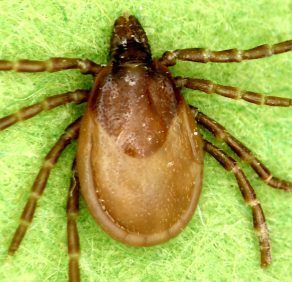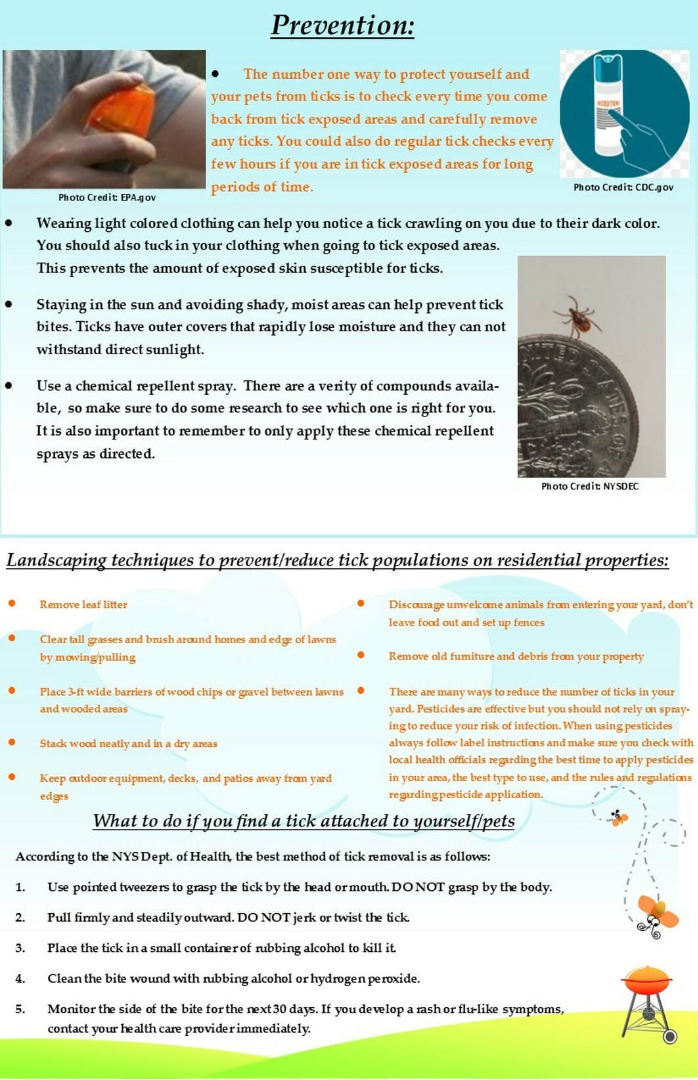Tick Information
Here you can findout how to protect yourself from ticks, the types of ticks to look out for, and a safe procedure for dealing with a tick bite.
Additional information about NCSWCD tick monitoring, control, and surveying can be found below.
Protecting yourself from Ticks
The #1 way to protect yourself and your pets from ticks is to check every time you return from an area that may contain ticks. Ticks do not jump, fly, or fall from trees. Ticks crawl close to the ground on leaves, brush, and wait on tall grass to jump onto a host. Stay on the trail! Steer clear of walking into areas with plants that will brush up against you. When ticks are not "questing" on plants, they rehydrate under leaves in the woods. Ticks need moisture to survive and tend to be found in shaded areas such as forest edges. The best way to avoid ticks is to walk in hot and dry areas with little vegetation, in the center of trails, mowed grass, and any areas without plants growing above ankle height.
Tips for avoiding ticks
-
Wear light colored clothing to help spot ticks that may attach to you. Wear a long-sleeved shirt and pants tucked into socks when walking in common tick areas to minimize risk.
-
Treating clothing with 0.5% Premethrin will repel ticks and last for multiple washes.
-
To kill remaining ticks on clothing, dry clothes after returning home. Tumble clothing on high heat for 10 minutes will kill any ticks remaining after your initial check. Dry before you wash, and ticks will die from a lack of moisture in the dryer.
-
Shower using a wash cloth to dislodge unattached ticks, and thoroughly check yourself when you shower over the next 48 hours
Know Your Enemy
All ticks pictured range from 1/4 inch to 1/16inch in size and have been drastically enlarged below to show detail

Lone-Star Tick

Deer Tick

American Dog Tick

Woodchuck Tick
Removing a tick
Prompt and proper tick removal may decrease your chances of getting tick-borne diseases. The steps are:
-
Use a fine-point tweezer to grasp near the head or mouth of the tick, as close to the skin as possible.
-
Pull firmly and steadily straight outward. Do not jerk or twist the tick.
-
Disinfect the bite wound with rubbing alcohol or hydrogen peroxide.
-
Place the tick in a small container of rubbing alcohol to kill it.
-
Record the date and location of the bite to monitor yourself for symptoms over the next 48 - 168 hours
**Do not use petroleum jelly, gasoline, lit matches, oils, or any other remedies to remove ticks. These methods may increase your chances of contracting a disease. **

Ticks and Tick-Borne Diseases
Blacklegged Ticks, also known as Deer Ticks (Ixodes scapularis), typically transmit Lyme disease, anaplasmosis, and babesiosis.
- Lyme disease is caused by the bacterium Borre/ia burgdorferi. A characteristic sign of Lyme disease is a red circular rash (bull'seye rash) that may appear a few days to a month, at the site of the bite, after being bitten by an infected tick. Multiple rashes may develop. About 60-80% of people who get Lyme disease develop a bull's-eye rash. Flu-like symptoms, such as fever, headache, fatigue, stiff neck, and muscle/joint pain, are also common in early Lyme disease. If left untreated, Lyme disease can cause complications such as recurring swollen and painful joints, temporary facial paralysis, or heart problems.
-
Anaplasmosis is caused by the bacterium Anaplasma phagocytophilum and may cause flu-like symptoms 1-3 weeks after the bite of an infected tick. Infection usually produces mild to moderately severe illness, with high fever and headache, but may occasionally be life-threatening or even fatal.
- Babesiosis is a rare and sometimes deadly disease caused by the protozoan Babesia microti. The disease can cause fever, fatigue, and hemolytic anemia lasting from days to months. It may take from 1-8 weeks for symptoms to appear.
Lone Star Ticks (Amblyomma americanum) typically transmit ehrlichiosis, tularemia, and Southern Tick-Associated Rash Illness (STARI).
- Within two weeks, symptoms appear, which include swollen lymph glands and a skin ulcer at the site of the bite of an infected tick. STARI is specifically associated with the bite of a lone star tick, but the cause of STARI is unknown. Individuals infected with STARI may develop flu-like symptoms and a bull's-eye rash. However, STARI itself does not appear to be serious or potentially fatal. Alpha-gal is a red meat allergy thought to be caused by bites of Lone Star ticks. Symptoms may start 3-6 hours after eating red meat and may include severe itching, hives, and in severe cases, cramping, vomiting, diarrhea, wheezing, shortness of breath, and loss of consciousness.
American Dog Ticks (Dermacentor variabilis) typically transmit Rocky Mountain spotted fever and tularemia.
- Rocky Mountain spotted fever (RMSF) is caused by the bacterium Rickettsia rickettsii. RMSF is characterized by a sudden onset of moderate to high fever (which can last for 2-3 weeks), severe headache, fatigue, deep muscle pain, chills, and rash, which begins on the legs/ feet or arms/hands, and may spread rapidly to the rest of the body. Symptoms usually appear within 2 weeks of the bite of an infected tick. Tularemia (see above).
Transmission: Ticks require a blood meal three times in their two-year life cycle. Ticks will attach to your skin and feed for 2-7 days, depending on the tick's stage. Studies have shown that the tick must stay on the body for about 36 hours to transmit Lyme disease. As a result, protective measures and prompt tick removal are essential in reducing your risk of infection.
Diagnosis and Treatment: Be sure to seek medical attention if you become ill after a tick bite. Generally, an evaluation of symptoms and blood tests will be used in making a diagnosis. Prompt diagnosis and treatment can improve outcomes. Your healthcare provider will determine the appropriate treatment for you.
Repellents
Repellents may be used to repel ticks and prevent tick attachment. Always read and follow all label directions carefully. Repellents containing DEET may be applied to the skin and clothing. Both the CDC and the American Academy of Pediatrics recommend that DEET not be used in children less than two months of age, and for children older than two months of age, the level should not be higher than 30 percent. For adults, the CDC recommends that the amount be between 20 and 50 percent. Repellents containing permethrin may be applied to clothing only.
Personal Protection
Ticks will remain active year-round (above 40° F/4.4°C). Preventive measures should be used whenever tick exposure is likely. Here are some steps to follow:
- Wear light-colored clothing
- Wear long pants and sleeves
- Tuck your pants into your socks
- Tuck your shirt into your pants
- Use repellents as directed
- Walk along the center of the trails
- Conduct frequent clothing checks
- Once home, dry clothing on the highest temperature setting for at least 10 minutes to kill any ticks
- Carefully inspect your body for ticks
- Keep pets from tick-infested areas and check them before entering the house
Learn more about tick monitoring, control, and repellents
-
North East Regional Center for Excellence in Vector-Borne Diseases - tick and mosquito research and outreach programs.
- CDC Vector Borne Diseases - tips on how to avoid mosquito and tick bites.
- NY Invasive Prism / Cornell - information on where ticks live, how to avoid them, and NY Integrated Pest Management.
- EPA Insect repellents safety - learn about different types of repellents, how the EPA assesses them, and tips on using them safely!
- Healthy Children - recommendations for using insect repellents on children.
- Consumer Reports - insect repellent product ratings.
Types of insect bite marks
A bite mark can be properly identified even after a bite has occurred by the marking of the rash.
Spider Bite
A spiders bite forms fluid filled bumps at the site of the bite
Tick Bite
Resemble a "bulls-eye" or a raised expanding solid patch
Insect Bite
Insect bites result in itchy or red raised skin reactions
Bee bites
Result in pain and a large amount of swelling in the area
Click on the images below to enlarge.



Nassau County Soil & Water Conservation District recently participated in the 2022 TICK BLITZ
surveying a collective 1,500 meters of Muttontown Preserve.
The NYS Tick Blitz is a yearly event created by the Northeast Regional Vector Control Center NEVBD. With help from Cornell Cooperative Extension CCE and NYS Integrated Pest Management NYIPM.
The purpose of the study is to study all NY regions simultaneously to understand where different tick species are present and track their northward expansion.
